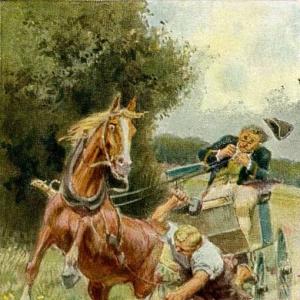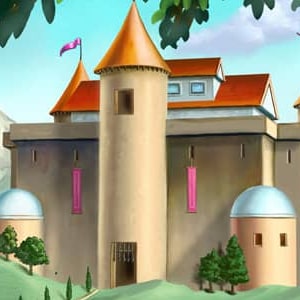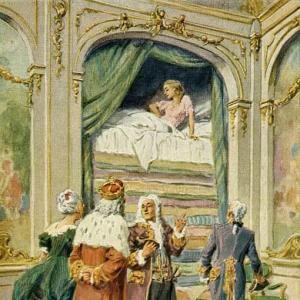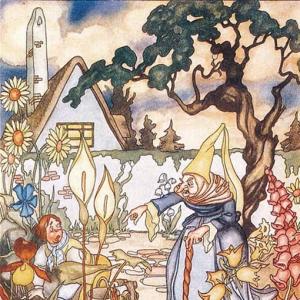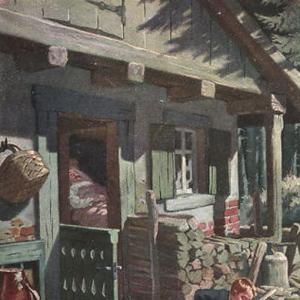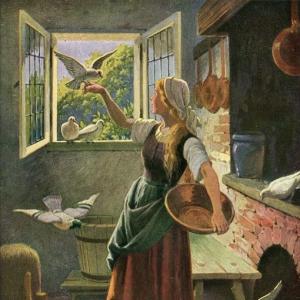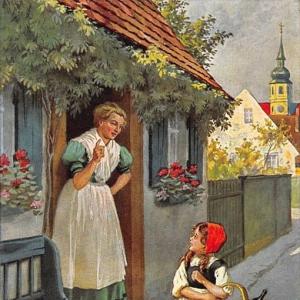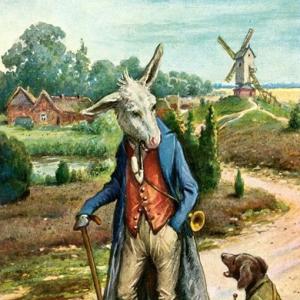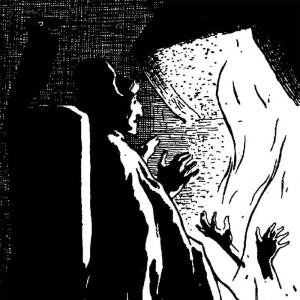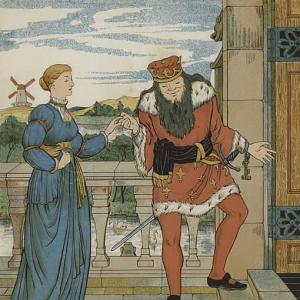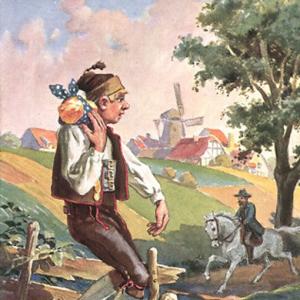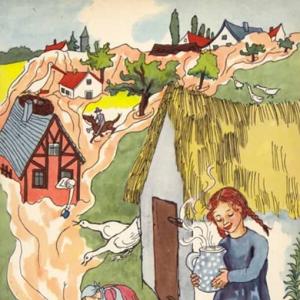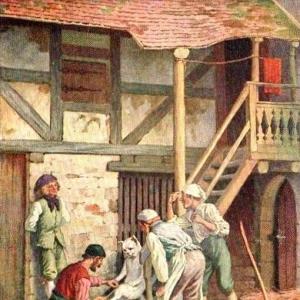Reading time: 6 min
Near the coast of Zealand, off Holsteinborg castle, there once lay two wooded islands, Vänö and Glänö, on which were villages, churches, and farms. The islands were quite close to the coast and quite close to each other. Now there is but one of these tracts remaining. One night a fierce tempest broke loose. The ocean rose higher than ever before within man’s memory. The storm increased. It was like doomsday weather, and it sounded as if the earth were splitting. The church bells began to swing and rang without the help of man.
That night Vänö vanished into the ocean depths. It was as if that island had never existed. But afterward on many a summer night, when the still, clear water was at low tide, and the fisherman was out on his boat to catch eel by the light of a torch, he could, on looking sharply, see Vänö, with its white church tower and high church wall, deep down below. He would recall the saying, „Vänö is waiting to take Glänö,“ as he saw the island, and he could hear the church bells ringing down there, but in that he was mistaken, for the sound came from the many wild swans which frequently rested on the water there, and whose clucking and complaining sounded like faraway church bells.
There was a time when there were still many old people on Glänö who well remembered that stormy night, and that they, when little, had ridden between the two islands at ebb tide, as we nowadays ride from the coast of Zealand over to Glänö, the water reaching up only to the middle of the wheels. „Vänö is waiting to take Glänö,“ it was said, and this saying was accepted as a certainty. Many little boys and girls would lie in bed on stormy nights and think, „Tonight the hour will come when Vänö calls for Glänö.“
In fear, they said the Lord’s Prayer, fell asleep, had sweet dreams – and the following morning Glänö was still there, with its woods and cornfields, its friendly farmhouses and hop gardens. The bird sang and the deer sprang. The gopher couldn’t smell sea water, however far he could dig. And still Glänö’s days were numbered. We could not say just how many there were, but they were numbered, and one beautiful morning the island would no longer exist.
You were perhaps down there at the beach on a day prior to this and saw the wild swans resting on the water between Zealand and Glänö, while a sailboat in full sail glided by the wooded shore, and perhaps you, too, rode across at low tide, with the horses trampling in the water as it splashed over the wagon wheels. You went away from there, perhaps traveled out into the wide world, and after a few years you have returned. You see the same woods, now surrounding a large, green meadow, where fragrant hay is stacked in front of pretty farmhouses. Where are you? Holsteinborg, with its golden tower spires, is still there, but not close to the bay.
It now lies farther up in the country. You walk through the woods, across the field, down toward the beach. Where is Glänö? You don’t see little wooded island before you. You see only the open water. Has Vänö finally taken Glänö, as it so long was expected to? On what stormy night did this happen, and when did an earthquake move old Holsteinborg so far inland?
There was no stormy night. It all happened on clear, sunny days. Human skill built a dam to hold back the ocean. Human skill dried up the water and bound Glänö to the mainland. The bay has become a meadow with luxuriant grass. Glänö has become part of Zealand. And the old castle stands where it always stood. It was not Vänö that took Glänö. It was Zealand that, through mechanical skill, gained many new acres of land. This is the truth. You can find it in the records. Glänö Island is no more.
 Learn languages. Double-tap on a word.Learn languages in context with Childstories.org and Deepl.com.
Learn languages. Double-tap on a word.Learn languages in context with Childstories.org and Deepl.com.Backgrounds
Interpretations
Summary
Linguistics
Hans Christian Andersen (1805-1875) was a Danish author and poet who is best known for his fairy tales. He was born in Odense, Denmark, and grew up in poverty, eventually becoming a prominent figure in Danish literature. Andersen’s works, which include stories such as „The Little Mermaid,“ „The Ugly Duckling,“ and „The Emperor’s New Clothes,“ have been translated into more than 125 languages and have become an integral part of the Western literary canon.
Andersen’s fairy tales are unique in their blend of fantasy, folklore, and moral lessons, often addressing universal themes like love, loss, and the passage of time. Though his stories were written for both children and adults, they often contain deeper meanings and messages that are understood by readers of all ages. Many of his tales feature elements of nature, emphasizing its beauty, power, and influence on human life.
„Vänö and Glänö“ is one of Andersen’s lesser-known stories, set near the coast of Zealand, Denmark. The story revolves around two islands, Vänö and Glänö, and explores themes such as the power of nature, human resilience, and the transition from superstition to knowledge and progress. While it might not be as famous as some of his other works, „Vänö and Glänö“ still provides valuable insights into Andersen’s imagination, storytelling style, and thematic concerns.
„Vänö and Glänö“ can be interpreted in various ways, highlighting themes such as the power of nature, human resilience, and the transition from superstition to knowledge and progress. Here are some possible interpretations:
Power of nature: The story demonstrates the destructive force of nature, as seen in the sinking of Vänö during a fierce storm. It also emphasizes the idea that natural events are often beyond human control and understanding, leading to the belief that Vänö would eventually take Glänö.
Superstition and fear: The tale highlights the role of superstition in people’s lives, as they attribute the fate of the islands to a supernatural phenomenon rather than natural events or human actions. The belief that „Vänö is waiting to take Glänö“ instills fear in the inhabitants, particularly children, who would worry about the impending disaster.
Human resilience and ingenuity: The story ultimately celebrates human resilience and ingenuity, as people come together to overcome their fear and the power of nature. By constructing a dam, they not only protect Glänö from the ocean but also incorporate it into the mainland, transforming the landscape and defying the old superstition.
Transition from superstition to knowledge and progress: The transformation of the islands and the landscape can be seen as a metaphor for the transition from superstition to knowledge and progress. As people develop new skills and understanding, they are able to overcome the limitations imposed by their fears and beliefs, ultimately shaping their world for the better.
Continuity and change: The tale explores the themes of continuity and change, as the landscape and people’s lives are constantly evolving. While some elements remain constant, like Holsteinborg castle, the disappearance of Glänö and the change in the landscape represent the inevitability of change and the need for adaptation.
Overall, „Vänö and Glänö“ offers a rich narrative that can be interpreted from different perspectives, highlighting the complexity of human relationships with nature, superstition, and progress.
„Vänö and Glänö“ is a fairy tale by Hans Christian Andersen, set on two wooded islands, Vänö and Glänö, near the coast of Zealand, off Holsteinborg castle. The islands were once close to each other and the mainland, but one night a fierce storm caused Vänö to sink into the ocean. The locals believed that Vänö was waiting to take Glänö, and children would worry about the fateful night when Vänö would call for Glänö.
Despite the superstition, Glänö remained intact, with its woods, cornfields, and farmhouses. On some nights, people could see the sunken island of Vänö below the water, hearing the ringing of church bells, which were actually the clucking of wild swans.
Years passed, and people returned to the area, finding the landscape changed. Holsteinborg castle had seemingly moved farther inland, while Glänö had vanished, leaving behind an open water view. It was not due to Vänö taking Glänö, but rather human skill that had built a dam to hold back the ocean and bind Glänö to the mainland, turning the bay into a meadow and incorporating Glänö into Zealand. The tale highlights the power of human ingenuity, defying superstition and fear.
The fairy tale „Vänö and Glänö“ by Hans Christian Andersen is a rich text for linguistic and thematic analysis, blending folklore with the narrative of natural and human-induced changes to the landscape.
Here are some key aspects to consider
Imagery and Descriptive Language: Andersen employs vivid imagery to evoke the setting and mood, particularly in descriptions of the tempest and the serene island landscapes. Phrases like „doomsday weather“ and „the ocean rose higher“ create a sense of foreboding, while descriptions of „still, clear water“ and „wild swans resting“ contribute to a tranquil atmosphere.
Legend and Folklore Elements: The repeated saying, „Vänö is waiting to take Glänö,“ functions like folklore within the story, encapsulating local beliefs and fears about the islands‘ fate. This reflects the oral tradition and community memory.
Personification: Nature and the islands are personified, adding depth to the narrative. The „wild swans“ whose „clucking and complaining“ is mistaken for „faraway church bells“ adds an eerie, mystical quality to the setting.
Symbolism: The islands symbolize impermanence and the passage of time. Vänö’s disappearance and Glänö’s eventual merging with Zealand metaphorically reflect changes that are inevitable in the natural world as well as those driven by human intervention.
Narrative Voice: Andersen employs a reflective and almost conversational narrative voice, engaging the reader directly with phrases like „You were perhaps down there“ and „You walk through the woods,“ which invites personal reflection and connection to the tale.
Thematic Analysis
Nature vs. Man: The narrative juxtaposes the power of natural forces (the storm that sinks Vänö) against human ingenuity (the dam that merges Glänö with Zealand). This theme explores the dynamic interaction between humans and their environment.
Change and Impermanence: The story conveys the inevitability of change, whether through the cataclysmic disappearance of Vänö or the gradual, human-engineered transformation of Glänö. The passage of time and the transition of landscapes reflect broader themes of loss and adaptation.
Memory and Myth: The persistent memory of Vänö and the fear of Glänö’s fate highlight how myths and legends grow from real events. Andersen contrasts the mythical belief that Vänö will reclaim Glänö with the reality of practical land reclamation.
Technology and Progress: The successful effort to bind Glänö to the mainland through „human skill“ highlights a theme of technological progress and its impact on the natural world, suggesting a tension between preserving nature and expanding human dominion.
Community and Belief: The story touches on the communal beliefs and shared stories that shape a society’s worldview. The transformation of the islands challenges these beliefs, reflecting on how communities adapt their narratives in the face of change.
Overall, „Vänö and Glänö“ is a multi-layered fairy tale that uses rich linguistic devices and thematic depth to comment on human interaction with nature and the inexorable currents of change.
Information for scientific analysis
Fairy tale statistics | Value |
|---|---|
| Translations | DE, EN, DA, ES |
| Readability Index by Björnsson | 27.4 |
| Flesch-Reading-Ease Index | 78.8 |
| Flesch–Kincaid Grade-Level | 6.1 |
| Gunning Fog Index | 7.7 |
| Coleman–Liau Index | 9.5 |
| SMOG Index | 7.9 |
| Automated Readability Index | 6.5 |
| Character Count | 3.720 |
| Letter Count | 2.905 |
| Sentence Count | 44 |
| Word Count | 677 |
| Average Words per Sentence | 15,39 |
| Words with more than 6 letters | 81 |
| Percentage of long words | 12% |
| Number of Syllables | 900 |
| Average Syllables per Word | 1,33 |
| Words with three Syllables | 29 |
| Percentage Words with three Syllables | 4.3% |

 Facebook
Facebook  Whatsapp
Whatsapp  Messenger
Messenger  Telegram
Telegram Reddit
Reddit